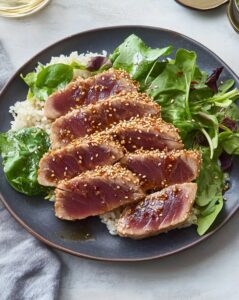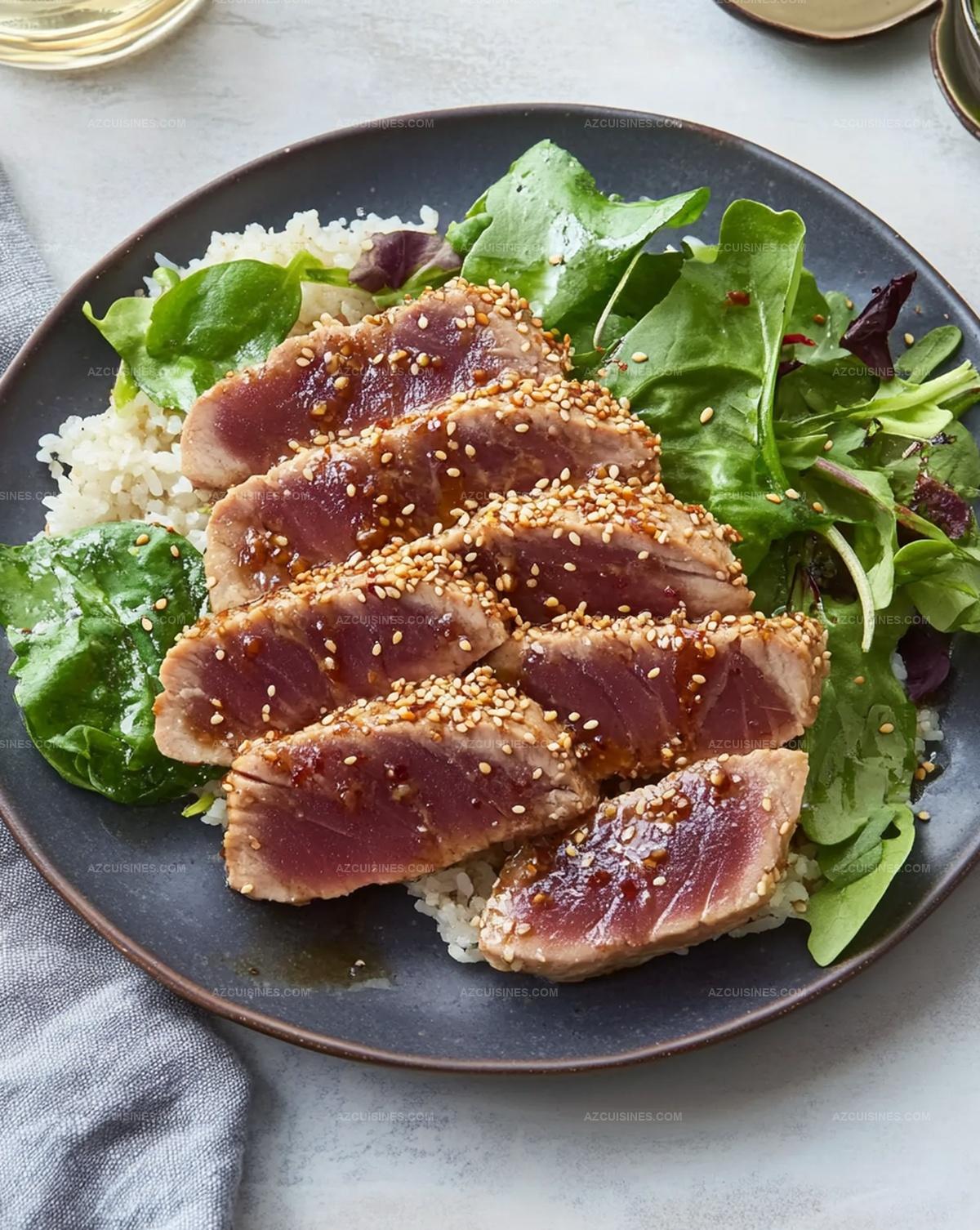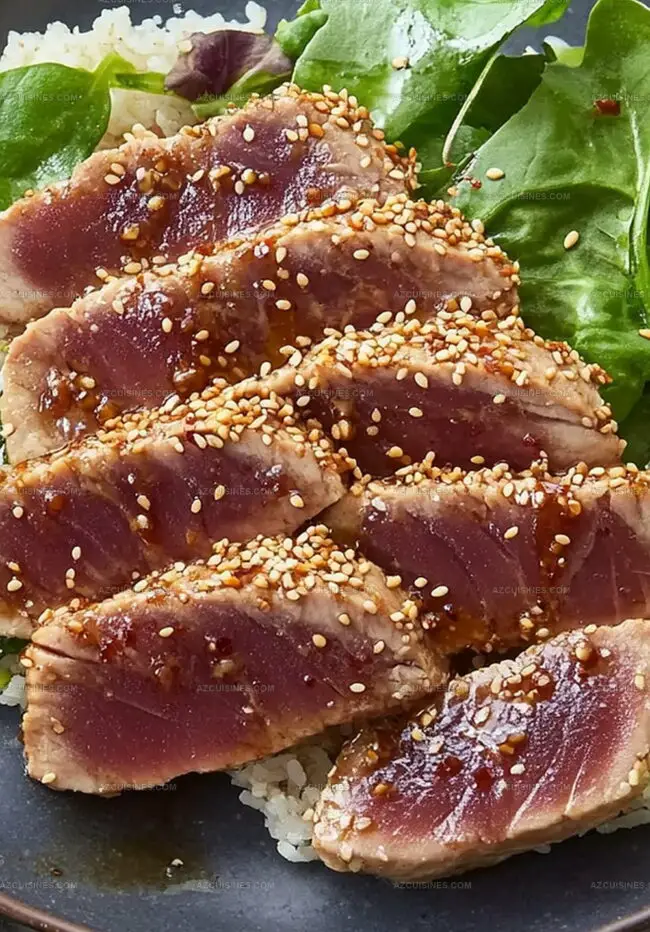Zesty Sesame Seared Tuna Recipe: Fresh Flavor in Every Bite
Crafting a sesame seared tuna dish promises an adventure in culinary precision and flavor.
Chefs worldwide celebrate this elegant protein for its delicate texture and rich maritime essence.
Restaurants often showcase this delicacy as a pinnacle of seafood preparation.
Selecting premium yellowfin tuna becomes crucial for achieving restaurant-quality results at home.
Delicate spice blends and precise searing techniques will elevate your plate from ordinary to extraordinary.
Each slice reveals a perfect gradient of caramelized exterior and ruby-red center that speaks to expert technique.
You’ll want to savor every nuanced bite of this sophisticated yet approachable seafood masterpiece.
Why Sesame Seared Tuna Packs Big Flavor
Ingredients For Sesame Seared Tuna
Protein Base:Marinade Ingredients:Aromatic Enhancers:How To Make Sesame Seared Tuna
Step 1: Whip Up a Flavor-Packed Marinade
In a shallow dish, create a delicious marinade by combining the following ingredients:Stir everything together until well blended.
Step 2: Bath the Tuna in Goodness
Nestle the tuna steaks into the marinade, ensuring they’re completely covered.
Let them soak up the incredible flavors for at least 10 minutes. Gently flip the steaks halfway through to guarantee even marinating.
Step 3: Roll in Crunchy Sesame Seeds
Spread sesame seeds evenly on a clean plate. Carefully remove the tuna steaks from the marinade and press them into the sesame seeds, coating both sides generously.
The seeds should stick perfectly to the surface.
Step 4: Sear to Perfection
Heat a non-stick pan over medium-high heat.
Carefully place the sesame-crusted tuna steaks into the hot pan. Sear for about 2 minutes on each side.
You’re looking for golden-brown sesame seeds and a beautiful sear that leaves the inside tender and rare.
Step 5: Slice and Serve
Remove the tuna from the pan and slice into thin, elegant pieces.
Serve immediately while the sesame crust is crispy and warm. Enjoy your restaurant-quality dish straight from your own kitchen!
Quick Tips For Sesame Seared Tuna
Fresh Takes On Sesame Seared Tuna
Best Pairings For Sesame Seared Tuna
How To Keep Sesame Seared Tuna Fresh
Sesame Seared Tuna FAQ Guide
Yes, but thaw it completely in the refrigerator first and pat dry with paper towels to ensure proper searing and prevent excess moisture.
Look for bright, deep red color, firm texture, and a clean ocean smell. Avoid tuna with brown edges or a strong fishy odor.
Use a sharp knife and slice against the grain in thin, even cuts to maintain the best texture and presentation.
Yes, high-quality sushi-grade tuna is safe when seared quickly at high heat, leaving the center rare. Always source from a reputable fishmonger.
Print
Sesame Seared Tuna Recipe
- Total Time: 14 minutes
- Yield: 2 1x
Description
Sesame seared tuna delivers a culinary masterpiece of Japanese-inspired elegance, blending rich flavors with pristine ocean freshness. Crisp sesame crust and tender pink center promise a gourmet experience that elevates seafood to an art form you’ll savor with pure delight.
Ingredients
Main Protein:
- 2 (5 ounces / 142 grams) ahi tuna steaks
Coating and Seasonings:
- 1/4 cup sesame seeds
- 2 tablespoons soy sauce
- 1 tablespoon rice vinegar
- 1 teaspoon sesame oil
- 1 teaspoon honey
- 1/2 teaspoon grated ginger
- 1/2 teaspoon minced garlic
- Salt and pepper to taste
Cooking Oils:
- 1 tablespoon olive oil
- 1 tablespoon mirin (optional)
Instructions
- Blend soy sauce, rice vinegar, olive oil, sesame oil, mirin, honey, ginger, and garlic in a shallow dish to create a robust marinade.
- Submerge tuna steaks in the liquid mixture, allowing flavors to infuse for 10-15 minutes, flipping periodically to ensure even coating.
- Spread sesame seeds on a flat surface, then carefully transfer marinated tuna onto the seeds, pressing gently to create a uniform crust on both sides.
- Preheat a non-stick skillet to medium-high temperature (around 400°F), ensuring the pan is hot before cooking.
- Carefully place sesame-crusted tuna into the skillet, searing for approximately 1-2 minutes per side to achieve a golden exterior while maintaining a rare to medium-rare interior.
- Remove tuna from heat and let rest for a brief moment to allow juices to redistribute.
- Using a sharp knife, slice tuna against the grain into thin, elegant strips.
- Plate immediately and serve with optional garnishes like green onions or pickled ginger to enhance the dish’s visual appeal and flavor profile.
Notes
- Choose sushi-grade or fresh tuna from a reputable fishmonger to ensure safe raw consumption and best flavor profile.
- Toast sesame seeds beforehand in a dry skillet to enhance their nutty aroma and provide deeper, more complex flavor.
- Pat tuna steaks completely dry with paper towels before coating with sesame seeds to help seeds adhere perfectly and create a crispy golden crust.
- Adjust searing time based on personal preference: 30-60 seconds per side for rare, 1-2 minutes for medium-rare, keeping center pink and cool.
- Prep Time: 10 minutes
- Cook Time: 4 minutes
- Category: Dinner, Appetizer, Snacks
- Method: Searing
- Cuisine: Japanese
Nutrition
- Serving Size: 2
- Calories: 415
- Sugar: 3 g
- Sodium: 800 mg
- Fat: 27 g
- Saturated Fat: 4 g
- Unsaturated Fat: 20 g
- Trans Fat: 0 g
- Carbohydrates: 16 g
- Fiber: 1 g
- Protein: 30 g
- Cholesterol: 70 mg




Truc Tran (Kris)
Senior Food Editor
Expertise
Home Cooking, Meal Planning, Recipe Development, Baking and Pastry, Food Editor, Cooking-video Maker, Vietnamese Food Evaluation Expert
Education
Truc Tran (Kris), an experienced food writer and editor, is great at exploring and describing global cuisines, from simple street food to fancy dining. In her writing, she skillfully mixes different flavors, cooking methods, and culinary traditions, showing the unique character of various cultures through their food and drinks. On azcuisines.com, Kris highlights her knowledge, especially in Asian cuisine and worldwide traditional dishes.